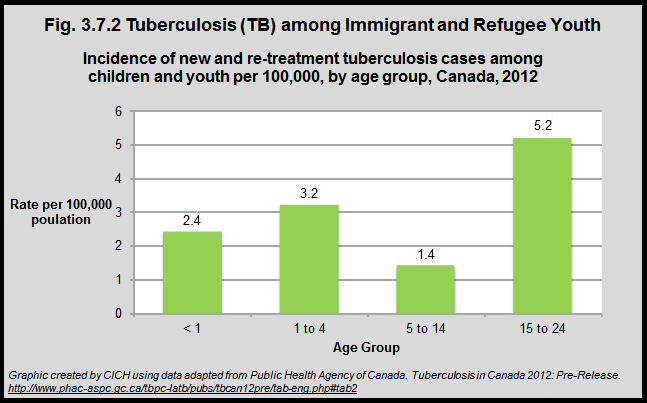Incidence of New & Re-Treatment TB Cases among Children and Youth per 100,000, by Age, 2012

Tuberculosis is an infection that is transmitted though airborne particles. It is an uncommon infection in Canada, but is still seen in indigenous populations and populations who are homeless. Immigrant and refugee children who have come from regions in the world where TB remains common are more likely to have TB. Foreign-born children, youth and adults account for 65% of all people with active tuberculosis in Canada, and some subgroups have up to a 500-fold greater risk of active tuberculosis relative to the non-Aboriginal Canadian-born population.1
In 2012 the rate of TB among children and youth ranged from 2.4 to 5.2 per 100,000 – depending on the age group. The rate of TB in the entire Canadian population in 2012 was 4.8 per 100,000 population. It was 13.6 among foreign-born children and adults, 29.4 among Canadian-born Aboriginal people and 0.7 among Canadian-born non-Aboriginal people.1
1Public Health Agency of Canada. Tuberculosis in Canada 2012: Pre-Release. http://www.phac-aspc.gc.ca/tbpc-latb/pubs/tbcan12pre/tab-eng.php#tab2M
Implications
Canadian Immigrant Health Guidelines recommend that immigrant children and youth under 20 years of age from countries with a high incidence of tuberculosis should be screened for TB with a tuberculin skin test as soon as possible after their arrival in Canada. It is recommended that they be treated for latent tuberculosis infection if the results are positive and active tuberculosis is ruled out. It is recommended that all newly arrived refugees, including children, should be assessed for latent TB infection – with the exception of those with past tuberculosis disease documentation.2
2Pottie K, Greenaway C, Feightner J, et al. Evidence-based clinical guidelines for immigrants and refugees. CMAJ 2011;183:E824-925
